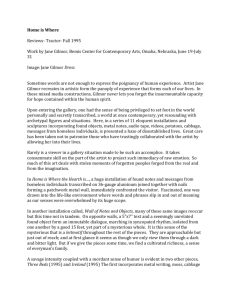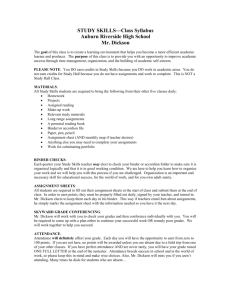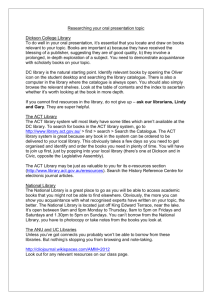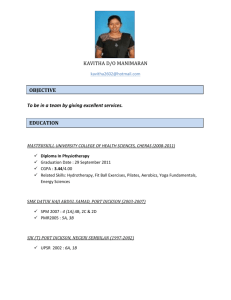Installation View Installation View
advertisement
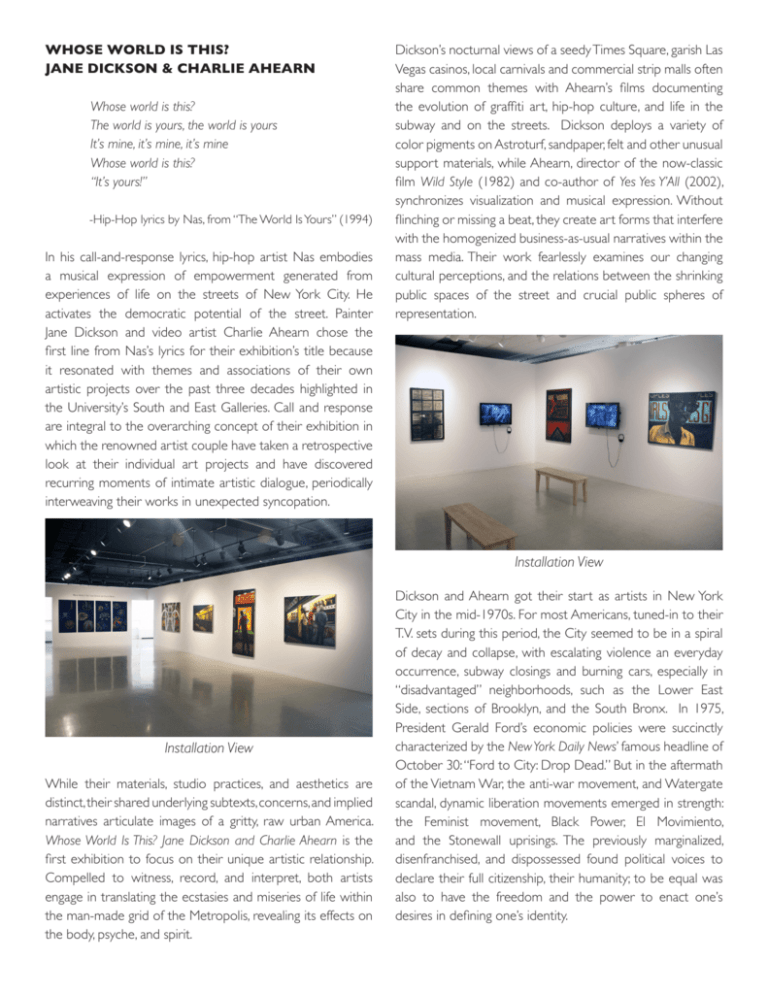
WHOSE WORLD IS THIS? JANE DICKSON & CHARLIE AHEARN Whose world is this? The world is yours, the world is yours It’s mine, it’s mine, it’s mine Whose world is this? “It’s yours!” -Hip-Hop lyrics by Nas, from “The World Is Yours” (1994) In his call-and-response lyrics, hip-hop artist Nas embodies a musical expression of empowerment generated from experiences of life on the streets of New York City. He activates the democratic potential of the street. Painter Jane Dickson and video artist Charlie Ahearn chose the first line from Nas’s lyrics for their exhibition’s title because it resonated with themes and associations of their own artistic projects over the past three decades highlighted in the University’s South and East Galleries. Call and response are integral to the overarching concept of their exhibition in which the renowned artist couple have taken a retrospective look at their individual art projects and have discovered recurring moments of intimate artistic dialogue, periodically interweaving their works in unexpected syncopation. Dickson’s nocturnal views of a seedy Times Square, garish Las Vegas casinos, local carnivals and commercial strip malls often share common themes with Ahearn’s films documenting the evolution of graffiti art, hip-hop culture, and life in the subway and on the streets. Dickson deploys a variety of color pigments on Astroturf, sandpaper, felt and other unusual support materials, while Ahearn, director of the now-classic film Wild Style (1982) and co-author of Yes Yes Y’All (2002), synchronizes visualization and musical expression. Without flinching or missing a beat, they create art forms that interfere with the homogenized business-as-usual narratives within the mass media. Their work fearlessly examines our changing cultural perceptions, and the relations between the shrinking public spaces of the street and crucial public spheres of representation. Installation View Installation View While their materials, studio practices, and aesthetics are distinct, their shared underlying subtexts, concerns, and implied narratives articulate images of a gritty, raw urban America. Whose World Is This? Jane Dickson and Charlie Ahearn is the first exhibition to focus on their unique artistic relationship. Compelled to witness, record, and interpret, both artists engage in translating the ecstasies and miseries of life within the man-made grid of the Metropolis, revealing its effects on the body, psyche, and spirit. Dickson and Ahearn got their start as artists in New York City in the mid-1970s. For most Americans, tuned-in to their T.V. sets during this period, the City seemed to be in a spiral of decay and collapse, with escalating violence an everyday occurrence, subway closings and burning cars, especially in “disadvantaged” neighborhoods, such as the Lower East Side, sections of Brooklyn, and the South Bronx. In 1975, President Gerald Ford’s economic policies were succinctly characterized by the New York Daily News’ famous headline of October 30: “Ford to City: Drop Dead.” But in the aftermath of the Vietnam War, the anti-war movement, and Watergate scandal, dynamic liberation movements emerged in strength: the Feminist movement, Black Power, El Movimiento, and the Stonewall uprisings. The previously marginalized, disenfranchised, and dispossessed found political voices to declare their full citizenship, their humanity; to be equal was also to have the freedom and the power to enact one’s desires in defining one’s identity. By 1979 both Dickson and Ahearn had become part of a group of New York artists known as Colab (aka Collaborative Projects, Inc.), a radical artists’ collective known for its ad hoc experimental art exhibitions that pushed the limits of artistic categories and launched graffiti and street art. In May 1977 Ahearn had organized the Municipal Arcade show, an outdoor sound and film event involving some of the artists who would later join Colab. At the start, over 40 artists made up the Colab membership; many artists had met at the Whitney Museum Studio Program (which Ahearn attended), as well as the San Francisco and Chicago Art Institutes. Early Colab artists included Jenny Holzer, Tom Otterness, Christy Rupp, Kiki Smith, and Robin Winters, among others. Dickson, Ahearn and their peers became specialists in creating “guerrilla art exhibitions,” installed temporarily in non-commercial, non-institutional venues. Their nomadic exhibitions and events joined together neighborhoods and artists; they became engaged in the dynamics of activism, resistance, and negotiation as well as in redefining a new artof-the-street. In 1980 Dickson and Ahearn made their mark in Colab’s exhibition in an abandoned massage parlor, The Times Square Show, now considered a cultural landmark for its do-it-yourself multimedia mix of film, painting, dance, slide shows, music, 3-D works, prints, cartoons, and graffiti. The show introduced artists such as Jean-Michel Basquiat, David Hammons, Keith Haring, Lee Quiñones, and Kenny Scharf. As Times Square’s collaborators and the designers of its “three-card-monte” exhibition poster, Dickson and Ahearn contributed work to many Colab shows including the Real Estate Show, the Dog Show, and the Two-Suitcase Show, all of which broke the narrow confines which at that time defined high and low art. In order to fully recognize Colab’s radicality of artistic intent, its cultural critique, and political implications, it is worth quoting at length from Colab’s “Manifesto or Statement of Intent,” from January 1980, written by the Committee for the Real Estate Show, a one-day art show installed in a burnedout building on Delancey Street: This is a short-term occupation of vacant city-managed property. It is pre-emptive and insurrectionary. The action is dedicated to Elizabeth Mangum, a middle-aged Black American killed by police and marshals as she resisted eviction in Flatbush last year. The intention of this action is to show that artists are willing and able to place themselves and their work squarely in a context which shows solidarity with oppressed people… It is important to show that people are not helpless--they can express their resentment with things-as-they-are in a way that is constructive, exemplary, and interesting… It is important to try to bridge the gap between artists and working people by putting artwork on a boulevard level… It is important to do something dramatic that is neither commercially oriented nor institutionally quarantined--a groundswell of human action and participation with each other that points up currents of feeling that are neither for sale nor for morticing into the shape of an institution. 1 Installation View Colab’s “Manifesto” and its philosophy were informed by concepts and wide-ranging practices formulated in earlier, politically charged avant-garde movements such as Dada, Situationism, the Beats, and Fluxus. But the specifics of Colab’s 1980 “Manifesto,” especially its emphasis on identifying racism, class differences, predatory capitalism, and its own alternative, nomadic “urban squatting,” were a broadside to the consumer culture’s status quo. Colab recognized and deployed a mix of text and image, comingled the personal and political, public and private. The “Manifesto” was a crucially collaborative project, a neighborhood project; it showed an awareness of the corporatization of public space and the crisis, for artists, in representing these disappearing spaces. Both Ahearn and Dickson had early experience with the paradoxes and complexities of artistic representation in and of public spaces. Dickson had studied computer animation in college, and soon after her arrival in New York, she got a job working on the Spectacolor computer billboard above Times Square, the neighborhood where she worked on and off from 1978-2008. In fact, it was under the Spectacolor billboard sign that Dickson first met fellow artist Ahearn in 1978 as she walked outside on her lunch break. If New York City was considered “Sin City,” then Times Square was the deepest level of Dante’s Inferno, a den of predators and victims, pimps, perps, junkies and hustlers. Dickson’s nightshift design job offered a clear-eyed view of urban noire, the brutal, neon-flecked architectural space compressing human desire and violence, testing each person’s capacity to absorb both wild fantasy and intensified reality. By 1977 Ahearn was headed down the street from his apartment on the Lower East Side with his Super 8 camera to the Alfred E. Smith Projects to film local youths practicing martial arts, which immediately engaged him with local MC and DJ parties and street performance. He began filming murals by graffiti artist George “Lee” Quiñones and got to know the local kids who were break-dancing. From these encounters, Ahearn completed his feature film Deadly Art of Survival in 1979, a raw, super-low-budget kung fu film featuring his neighborhood’s martial arts students and their mentors. In the South Bronx, Ahearn brought his Super 8 projector to show his kung fu film, while neighborhood kids gathered around to do a live performance. It was a call-and-response performance: collaboration by Ahearn, local artists and the neighborhood. In the summer of 1980, Ahearn followed up by working with Fred Brathwaite and Quiñones on the now-classic hip-hop film Wild Style (clips of the film are featured on a flat screen monitor in the East Gallery), which was first screened in 1982 and has continued to be an inspiration to and influence on new generations of artists, musicians, and writers. As a gritty, true-to-life docudrama, Wild Style places the viewer in the midst of the unscripted lives of young hip-hop pioneers, graffiti writers, scratch-mixing and break dancers (Busy Bee, Cold Crush Brothers with Grandmaster Caz, Dondi, Zephyr, Daze, Lady Pink, Patti Astor, among others), culminating in a huge concert outdoors, a marriage of participatory art and music of the street. fleeting moments in the street. From her apartment window on 43rd Street and 8th Avenue, she photographed and painted Times Square using dynamically framed, cinematic angles, capturing fragmented silhouettes in raking light, voyeuristically half hidden; furtive shadows blasted by garish lights. Loneliness and anticipation permeate the atmosphere. Anxiety and watchfulness dominate the painted scenes, as in Dobbs Hats (1981), Fred (“Fab Five Freddy” Brathwaite, 1983), Cops in Headlights I (1990), Witness (BE) II (1990) and Peep 3 (1992-6) installed in the East Gallery. Ahearn and artist friends would often pose for Dickson’s snapshots inside the apartment building, leaning to glance over stairway railings or seeming to scurry for cover between interstices in a vertigoinducing choreography of “half-in and half-out” frameworks, resulting in paintings of borderless physical and psychological spaces. These feelings of unease and discomfiting emotions, manifest in gestures as figures move between spaces and within particular places, are revealed in Ahearn’s 1993 video Jane in Peepland (featured on a flat screen monitor in the East Gallery). Fred, 1983 Wild Style, 1982 The filmmaker follows Dickson as she reenacts in her apartment, on the street, and in the subways, possible scenarios from her paintings. She confesses her innermost fears and nightmares to the camera, which she then mediates by photographing, drawing, and painting. A compelling complement to her paintings, the film taps into Dickson’s artistic and psychological energies, her conflicting and paradoxical experiences in the City, and the tensions and ambiguities in her paintings’ content. In order to construct narratives for what he was experiencing, Ahearn shot photographs to inspire his storyboards for films. Dickson began taking her camera everywhere to capture the Ahearn and Dickson married in 1983, continuing their individual careers as artists while they began to raise a family, living in the Times Square area until 1993, when they moved to downtown Tribeca, which at that time was rundown and decrepit. The Downtown art scene (c. 1974-1984), cogently described by Carlo McCormack as “the ten-year period of manic creativity” which percolated in storefront spaces, bars, street corners, and nightclubs was attacked during the “culture wars” by the conservative political backlash, which was determined to dismantle the cultural revolutions of the 1960s, during the administration of President Ronald Reagan.2 As the 1980s progressed, the Iran-Contra scandal emerged in the shadow of the Reagan Doctrine and the disastrous effects of Reaganomics were manifest in an extraordinary number of bank failures; urban America was hit especially hard. But the indelible mark of the decade was the staggering loss of life from both the HIV/AIDS epidemic and the crack cocaine epidemic. designed to promote multifarious forms of desire, whether for products, lifestyles, identities, conformity or security. As the number of multinational corporations expanded and the term “corporate greed” was first coined, mass media and media streams began to filter any personal event or experience. The sphere of media representation, as the site within which desire is articulated in the overlapping realms of culture and politics, consciously defines how images carry ideas, emotions, and visions of history, or myth. It was no coincidence that the French sociologist, philosopher, and polymath Jean Baudrillard wrote in 1980: “Disneyland is presented as imaginary in order to make us believe that the rest is real, when in fact all of Los Angeles and the America surrounding it are no longer real, but of the order of the hyper-real and of simulation.” 3 Witness (BE) II,1990 Peep 3, 1992-6 The ad men who packaged the former actor Reagan, nicknamed the “Teflon President,” assembled a systematic, political media culture of “the spectacle” for the T.V. generation’s consumption (Guy Debord’s The Society of the Spectacle was published in 1967). Public and private spheres were increasingly permeated by the image world of mass media, circulating a never-ending game of “three-card-monte” By the time Dickson’s mini-retrospective of her trenchant figurative paintings from the 1980s, “Paradise Alley,” was on view at the Whitney Museum at Philip Morris (1996), the city blocks of concentrated desire, desperation, and vice comprising Times Square were being gradually replaced by what the popular press called, “Disneyfication.” Today the Disney flagship store (“We can’t stop sprinkling the Pixie Dust!”4) prominently resides in Times Square. Its clones create elaborate artificial environments- “Main Street U.S.A.” -designed to appear “absolutely realistic,” taking visitors’ imaginations to a past that is an illusion.5 This realistic-looking “fake” makes it even more desirable for people to purchase the illusion as consumers. The system enables visitors to feel that technology and the created atmosphere of “Disneyfication” is “better,” more desirable than nature. Immersion in a hyperreal space like a Disneyland, a computer game, a home entertainment center, a movie or a casino gives the subject the impression that she is walking through a fantasy world where everyone is playing the game. The contemporary cultural critic and historian Norman Klein describes these simulations as labyrinthine scripted spaces, “for a soothing journey into a sublime nowhere.” 6 All City – Take It To the Bridge, 2010 Since the 1980s, both Dickson and Ahearn have worked as artists to understand their increasingly media-saturated world and its effects on perception and desire. Key to bearing witness is the visual translation about what is often hidden from view within the systems of mass media and media streams. Each artist employs a particular medium to transpose into the present observations about what was “really” going on in the past, what was nascent and not fully recognizable, and what, at an accelerated pace, is streaming in to structure our psyches now from our ubiquitous array of smart phones, iPods, PDAs and other electronic gadgets. Figuration is the vehicle for both artists and it is flexible enough to accommodate either a narrative impulse or poetic metaphor. The figure invites projection and identification for artists and viewers alike. For example, Ahearn’s more recent musical short with MC crew Nine 11 Thesaurus, brass band Lucky Chops, and vocal percussionist DOA perform in All City - Take It to the Bridge (2011), is featured on a flat screen monitor in the East Gallery. The filmmaker employs a loose narrative structure but allows for ad hoc creativity to emerge in the two major scenes: call-and-response hip-hop jamming in the local pizza parlor and ad hoc musical collaboration by Nine 11 Thesaurus, Lucky Chops, and DOA, walking and performing on the Brooklyn Bridge.The viewer learns that the arc of the narrative is a commemoration of the 9/11 tragedy; members of these music groups had family members affected on that ill-fated day. Survivors silently crossed the Brooklyn Bridge on their way home that afternoon. In his video, Ahearn eloquently rendered the Bridge as a vehicle for crossing-over, a symbol of time, and a threshold between worlds, with the help of the performers, including the crowds who gather to watch the performance. The filmmaker’s newest videos, Subway shorts (2012), are non-narrative and explore a series of brief poetic gestures from subway performers to highlight the democratized public space of the subway. Paintings from Dickson’s new series installed in the South Gallery, “Las Vegas” (2009-2011) and “Dreamland” (20112012), and paintings such as San Genaro Up in the Air (200712), Check Your Speed 3 Balls (2005), Shoot the Stars (2005), and Lucky Food Center (2002) address many of the themes of “Disneyfication.” Her paintings interpret the interiors of wired-up video gaming and gambling environments which have become ubiquitous “leisure-time” distractions, absorbing large chunks of the daily life and the dream-life of millions of Americans. Dickson keeps the sleek but eerie architectural subject deep within the framework, where an artificial virtual reality cushions and fashions a dream-like scene: where there is no day or night, and no delineation of dreaming or waking states of consciousness. Everything is brightly videoscreened, ambient, and carpeted. Desire is free-floating and fantasy reigns. Dickson depicts the ways in which many of us spend hours and hours of our lives; and she does not exclude herself. Digital technology and nanotechnology often create both physical inertia and mental distraction; Dickson’s figures are intently bent over the virtual blue screens, captivated by the color, light and shapes of illusion. Faceless bodies seem swallowed up by this artificial world. Dickson knows the Lucky Food Center, 2002 sensations, the atmosphere and ineluctability of these spaces, her empathy adds a humanistic element to these drifters, caught in the seduction. In Dreamland Quartet (2012), deep blue felt is the smooth tactile support material for eye-popping, intense acrylic shapes, candy-colored spheres abstracted from a bird’s eye view; the viewer is floating above and looking down on a fragmented scene of luscious delight. Disorientation results from the four vertical swaths evoking sensations and childhood memories of spinning tops and twirling stripes of circus tents. Discussing the contexts for her new Las Vegas and Dreamland paintings, Dickson recently stated: I’m as seduced as anyone by the overwhelming energy of the city, my brilliant friends, the internet… I’m driven to distraction by my desire to keep up with more than is humanly possible. I’ve been thinking about how this attraction/seduction/distraction paradox is structural to our hyper-commercialized culture. Our attention is hijacked every few seconds by systems designed by the best minds money can buy. Like everyone else, I’m struggling with the internet’s huge new layers of virtual info/distractions. Entering that seemingly endless maze of disorienting patterns and shapes [Las Vegas casinos], flashing lights and crazy music, what Rem Koolhaas called the “Synthetic Reality of Fantastic Technology,” I realized I had entered the 3-D precursor to the internet’s labyrinth of temptations. I took hundreds of pictures, many of people at slot machines. When I got home and looked at them I realized what interested me was the architecture and the way it swallows everyone. Slot machines look like computer terminals. We get away from work and then are riveted by these screens, losing money, thinking we’re having fun. To borrow from Koolhaas, technology of the fantastic was used to create a synthetic reality… There are always things in your face going, “Look at this. Don’t you want it?” 7 Installation View Ahearn and Dickson traveled together to Las Vegas in 2010 for an international break-dance competition and to continue research of the casinos and malls of the 24/7 “Entertainment Capital of the World,” as the city bills itself: “The lights dim. Your clients take their seats and the curtain goes up. Who or what takes the stage next is up to you.This is where over-thetop seems like a good place to start. These are Vegas shows after all.” 8 Unlike these packaged deals, Ahearn’s digital video Las Vegas Flip (2010), featured on a flat screen monitor in the South Gallery alongside Dickson’s “Las Vegas” paintings, offers an alternative vision of the entertainment capital’s strips. Shot surreptitiously on the filmmaker’s smartphone on the streets of the Casinos’ desiring-machine and hermetically sealed dens, the abrupt and candid segments feature passersby, including entire families, at all times of the day and night, bored, sleepy, anxious, and distracted. We follow Dickson wandering through the labyrinthine environment, sampling a game or two at the slot machines. The scripted narrative of the labyrinth, however circuitous, is calculated down to the last coin, and the bank always wins in the end. Everyone pays for the spectacle, the ride. Rather than a smoothly polished verisimilitude or a crafted collage of fragmented shots, Ahearn’s disorienting film jars our senses, opens our eyes, and doubles the vertigo induced by Dickson’s obliquely angled perspectives. Cops in Headlights I, 1990 Integrated on aisle walls of Ben Shahn’s South Gallery and arranged in a visual dialogue with Ahearn’s photographs of long-time friends from the early hip-hop movement are Dickson’s recent oil portraits on Yupo of hip-hop and graffiti stars; many of whom had come to the opening of the ground breaking Art in the Streets exhibition at Los Angeles’ Museum of Contemporary Art (2011), which also featured Ahearn and Dickson’s work. Continuing on the aisle walls, Dickson and Ahearn collaborated on-site in a unique visualization of their artistic call-and-response dialogue by assembling a chronological flow of their photographs and prints (19792012) as process-related catalysts that became scenes in Ahearn’s videos and images in Dickson’s paintings.The photochronology flows on down the aisle walls and rounds the corner in conjunction with the oil on Yupo and photographic portraits. As Ahearn reminds us, the artistic dialogue between artists and the street continues: 1 I am involved in the confluence between art and the street, between music and the visual. There is a lot of Hip Hop today that has that same feeling that I got from kids in the South Bronx in 1980. I just did a project in Brooklyn with a group and they are just as radical as any group you would ever meet anywhere, they are totally street, totally political, they are noncommercial, they are hardcore beautiful people and they are still doing it. Hip Hop is definitely alive and well. I am working with this radical group called Nine 11 Thesaurus. The ramifications of the commercialization of the culture have not in any way weakened its power at all in the past 30 years. 9 4 Dickson and Ahearn recognize our individual subjectivities, visual and musical, tactile and kinesthetic, as an uncontrollable mixture of all the competing and paradoxical qualities of living in a “global” time period, connected within local neighborhoods as well as within larger urban social spaces. Both artists are rooted in The Street as a site for public intervention, as a place to seek out alternative stories and ways of being. They work with the existing repertory of cultural imagery and reveal the slippage or difference prompted in the interplay of power and illusion in contemporary America within spaces such as shopping malls, theme parks, casinos, carnivals and other cyber “Disneylands.” Their work in the exhibition examines our appetites and capacities for perception, collective and individual memory, spatial memory, and the politics and aesthetics of public space. See [Online]: http://www.abcnorio.org/about/history/res_ manifesto.html and http://98bowery.com/returntothebowery/ abcnorio-the-real-estate-show.php [Accessed 2 September 2012]. 2 Carlo McCormack, “A Crack in Time,” The Downtown Book: The New York Art Scene 1974-1984, ed. Marvin J. Taylor (Princeton and Oxford: Princeton University Press and the Grey Art Gallery and the Fales Library, NYU, 2006-7), 67. For a critical, alternative art historical perspective see Helen Molesworth, This Will Have Been: Art, Love & Politics in the 1980s (Chicago and New Haven; MCA Chicago in association with Yale University Press, 2012). 3 Jean Baudrillard, “Simulacra and Simulations,” Jean Baudrillard, Selected Writings, ed Mark Poster (Stanford, CA: Stanford University Press, 2001), 175. [Online]: www.stanford.edu/ dept/HPS/Baudrillard/Baudrillard_Simulacra.html [Accessed 2 September 2012]. See [Online]: http://blog.disneystore.com/blog/2011/06/disneystore-times-square-adds-more-magic.html [Accessed 2 September 2012] 5 Umberto Eco, Travels In Hyperreality (New York: Harcourt Brace Jovanovich, 1986), 43. 6 Norman Klein, “Special Effects Environments: from the Renaissance to the Present,” synopsis of the book in progress, 1995, [Online]: http://www.manovich.net/Klein.html [Accessed 2 September 2012]; Norman Klein, The Vatican to Vegas: A History of Special Effects (New York and London: New Press, 2004). 7 See Dickson’s interview [Online]: http://missrosen.wordpress. com/2010/08/11/jane-dickson/ [Accessed 2 September 2012]. See also, Rem Koolhaas Delirious New York: A Retroactive Manifesto for Manhattan (New York: Monacelli Press, 1994). See also Irving Lavin, “Going for Baroque: observations on the post-modern fold,” in Sebastian Schuetze, ed. Estetica barocca. Atti del convegno internationaale tenutosi a Roma dal 6 al marzo 2001 (Rome, 2004), 419-446. Lavin writes that Erwin Panofsky saw the Baroque as the first modern era ushering in a new psychological awareness and self-consciousness. 8 See [Online]: http://www.visitlasvegas.com/travel-professionals/ commissionable/entertainment/ [Accessed 2 September 2012]. 9 - Deborah Frizzell, Ph.D. See [Online]: http://missrosen.wordpress.com/2010/08/09/ charlie-ahearn-down-by-law/ [Accessed 2 September 2012]. j Whose World is This? Jane Dickson and Charlie Ahearn Curated by Deborah Frizzell September 10 – October 19, 2012 1. Jane Dickson LV76 (Gameboy 4), 2012 Oil on linen 52 x 72 inches Courtesy of the artist 2. Jane Dickson LV36 (Orange Roof), 2011 Oil on canvas 24 x 24 inches Courtesy of the artist 3. Jane Dickson LV37 (Orange Roof 2), 2011 Oil on canvas 24 x 24 inches Courtesy of the artist 4. Charlie Ahearn Las Vegas Flip, 2010 Video 8:00 minutes Courtesy of the artist 4. Jane Dickson LV59 (Large Skull T), 2011 Oil on canvas 48 x 30 inches Courtesy of the artist 5. Jane Dickson LV75 (Wheel of Fortune 2), 2011 Oil on canvas 49 x 84 inches Courtesy of the artist 6. Jane Dickson San Genaro Up in the Air 1, 2011 Oilstick on linen 74 x 54 inches Courtesy of the artist 7. Jane Dickson Lucky Food Center, 2002 Oil on astroturf 41 x 50 inches Courtesy of the artist 8. Jane Dickson Dreamland Quartet, 2012 Acrylic on felt Each panel 128 x 32 inches Courtesy of the artist 9. Jane Dickson 12 San Genaro Up in the Air 2, 2007 Oilstick on linen 52 x 72 inches Courtesy of the artist 10. Jane Dickson Penn Car Speedway Concession, 2002 Oil on linen 40 x 54 inches Courtesy of the artist 11. Jane Dickson Check Your Speed 3 Balls, 2005 Oilstick on linen 83 x 40 inches Courtesy of the artist 12. Jane Dickson Shoot the Stars, 2005 Oilstick on linen 48 x 60 inches Courtesy of the artist 13. Jane Dickson HH11 (Bootleg T White), 2011 Oil on Yupo 11 x 14 inches Courtesy of the artist 14. Jane Dickson HH22 (KRS1 Vert), 2011 Oil on Yupo 14 x 11 inches Courtesy of the artist 15. Jane Dickson HH32 (AD & JDL Bandshell), 2011 Oil on Yupo 11 x 14 inches Courtesy of the artist 16. Jane Dickson HH14 (? LA Green), 2011 Oil on Yupo 11 x 14 inches Courtesy of the artist 17. Jane Dickson HH20 (Peeking), 2011 Oil on Yupo 11 x 14 inches Courtesy of the artist 18. Jane Dickson HH16 (San Genaro Pink Pig), 2011 Oil on Yupo 11 x 14 inches Courtesy of the artist 19. Jane Dickson HH9 (Breaker Family 1), 2011 Oil on Yupo 9 x 12 inches Courtesy of the artist 20. Jane Dickson HH6 (Patti & Caz), 2011 Oil on Yupo 9 x 12 inches Courtesy of the artist 21. Charlie Ahearn DJ Theodore Scratch, 1980 C-print, mounted 40 x 60 inches Courtesy of the artist 22. Jane Dickson Dobbs Hats, 1981 Acrylic on vinyl 48 x 52 inches Courtesy of the artist 23. Jane Dickson Cops in Headlights I, 1990 Oil on canvas 50 x 36 inches Courtesy of the artist 24. Charlie Ahearn Jane in Peepland, 1993 Video 20:00 minutes Courtesy of the artist 25. Jane Dickson Witness (BE) II, 1990 Oil on rolodex on canvas 48 x 30 inches Courtesy of the artist 26. Charlie Ahearn Subway Sampler, 2012 Video 7:00 minutes Courtesy of the artist 27. Jane Dickson Peep 3, 1992-6 Oil on rolodex on canvas 57 x 40 inches Courtesy of the artist 28. Charlie Ahearn Wild Style clips, 1982 Video 9:00 minutes Courtesy of the artist 29. Charlie Ahearn All City – Take It To the Bridge, 2010 Video 6:30 minutes Courtesy of the artist 30. Jane Dickson Fred, 1983 Acrylic on vinyl 40 x 50 inches Courtesy of the artist
